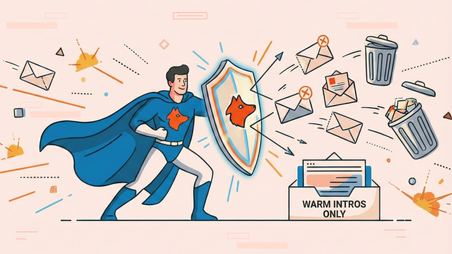Rejection-Then-Retreat: How To Change Your CTA After No Reply

Getting no replies to some of your cold emails is a harsh outbound reality.
Depending on the specifics of your campaign, you should feel accomplished if you get a reply rate of anywhere from 10 to 20%, which means the vast majority of your cold emails won’t get a reply.
There are many possible reasons why some of your emails won’t produce yes: deliverability, targeting, timing, and even copywriting all come into play.
However, sometimes, it’s simply your CTA and, more specifically, the extent of the commitment you request from your recipient.
If the ask you make in your cold email is big, some of your recipients won’t act on it no matter what.
But you can plan a follow-up sequence that gives you another opportunity to reach them despite the initial failure.

The persuasion technique you can use as inspiration here is called rejection-then-retreat.
What is rejection-then-retreat?
Rejection-then-retreat (also known as “door in the face,” a less elegant name) is a popular sales technique.
As far as I can tell, the name was coined by Robert Cialdini, a renowned social psychologist, and persuasion expert.
Rejection-then-retreat means making your initial request (or CTA) large and, when it’s turned down by the prospect, making a smaller request.
Because of how powerful the rule of reciprocity is in social interactions, rejection-then-retreat can make your prospect more likely to agree to the smaller request.

Reciprocity is typically associated with unsolicited favors that people feel inclined to repay. However, reciprocity is also evoked when you concede in a social situation. That’s because when you make a concession from your initial request, your prospect may perceive it as a favor and feel obligated to reciprocate.
To be clear, the rejection-then-retreat technique is primarily used in direct sales, and it’s planned for. Meaning the salesperson makes their initial request too large on purpose only to make the prospect more likely to say yes to the consecutive, smaller ask.
How rejection-then-retreat can be used in cold emails
Typically, cold emails use the exact opposite of rejection-then-retreat.
You normally want to make your CTA as easy as possible for the recipient to act on. There are two reasons why:
- If you can produce an initial “yes,” you can build on it because people generally like to be consistent in their actions. This means that if they responded positively to your first email, they feel inclined to continue the relationship.
- Getting positive engagement is crucial for your sender reputation, so it only makes sense to optimize for a high positive reply rate.
This tactic of asking for minimal commitment also has a name in the social psychology field – it’s known as the “foot-in-the-door” technique.
But while getting your foot in the door is a great goal for your first email, you should still plan for what happens if it doesn’t work.
You should always follow up on your cold emails. And follow-ups are your opportunity to try other angles, arguments, and persuasion techniques.
I recommend using the rejection-then-retreat in your last email in the sequence.

Instead of making it a “breakup” message and informing the recipient you’ll no longer contact them, use it to make a concession. Ask for something that removes the weight of the decision from your recipient:
- Say you want to stay in touch via LinkedIn,
- Ask for a referral to a more suitable recipient at the company,
- Ask about a better time to contact them,
- Ask about their current priorities that prevented them from replying before.
You can even combine some of these, so the recipient can act in the way that’s most comfortable at the time. Your goal here is to end the sequence on a positive note, however minor it may be.
Wrapping up
Remember that rejection-then-retreat is not really a tactic that applies to the first cold email in your sequence. If you make an outrageous ask in your first email, it may backfire – your recipients may unsubscribe or report your message as spam.
However, even though you should have a WARM goal for your cold email, you can still consider using rejection-then-retreat in your follow-ups.




 Send cold emails with Hunter
Send cold emails with Hunter